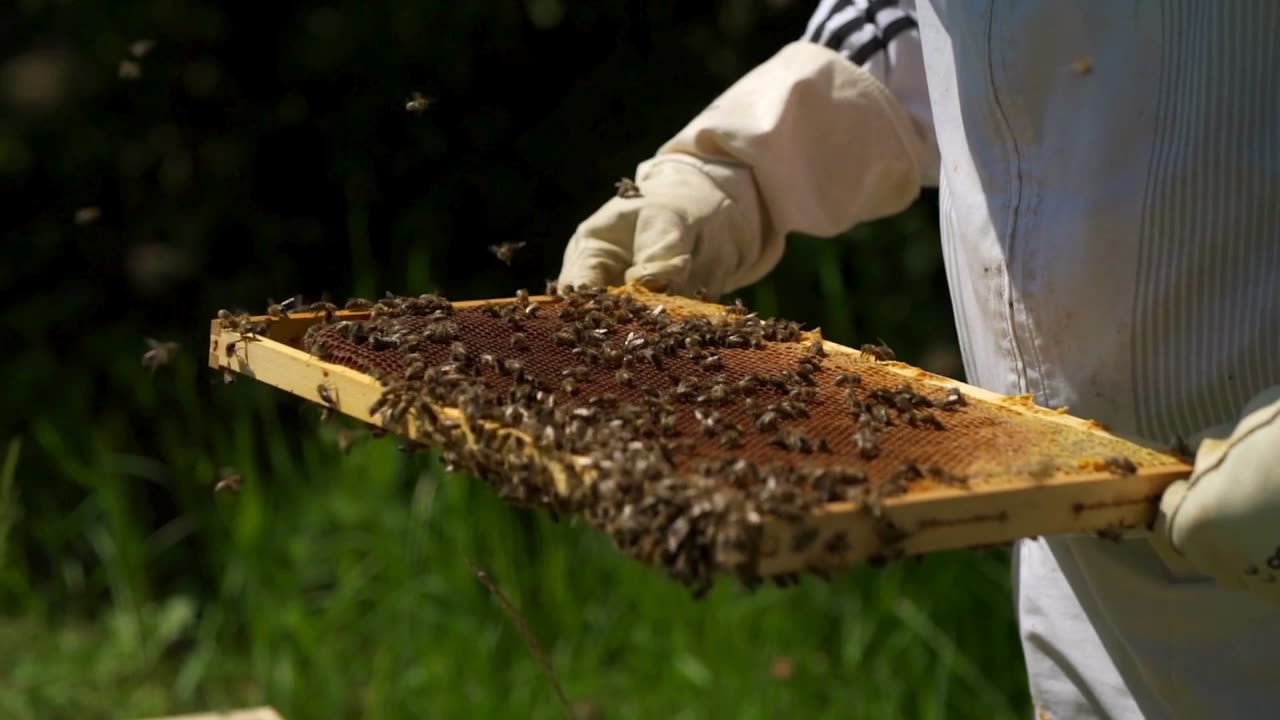Premium Only Content

Honey Bees Make Honey and Bread
BLOSSOMED is a ultra-HD (4K) short video series created by KQED San Francisco and presented by PBS Digital Studios. See the unseen at the very edge of our visible world. Explore big scientific mysteries by going incredibly small.
Spring means honey bees flitting from flower to flower. This frantic insect activity is essential to growing foods like almonds, raspberries and apples. Bees move pollen, making it possible for plants to grow the fruit and seeds they need to reproduce.
But honey bees don’t just move pollen from plant to plant. They also keep a lot for themselves. They carry it around in neat little balls, one on each of their hind legs. Collecting, packing and making pollen into something they can eat is a tough, intricate job that’s essential to the colony’s well-being.
Older female adult bees collect pollen and mix it with nectar or honey as they go along, then carry it back to the hive and deposit it in cells next to the developing baby bees, called larvae. This stored pollen, known as bee bread, is the colony’s main source of protein.
“You don’t have bees flying along snacking on pollen as they’re collecting it,” said Mark Carroll, an entomologist at the US Department of Agriculture’s Carl Hayden Bee Research Center in Tucson. “This is the form of pollen that bees are eating.”
--- What is bee bread?
It’s the pollen that worker honey bees have collected, mixed with a little nectar or honey and stored within cells in the hive.
--- What is bee bread used for?
Bee bread is the main source of protein for adult bees and larvae. Young adult bees eat bee bread to make a liquid food similar to mammal’s milk that they feed to growing larvae; they also feed little bits of bee bread to older larvae.
--- How do honey bees use their pollen basket?
When a bee lands on a flower, it nibbles and licks off the pollen, which sticks to its head. It wipes the pollen off its eyes and antennae with a brush on each of its front legs, using them in tandem like windshield wipers. It also cleans the pollen off its mouth part, and as it does this, it mixes it with some saliva and a little nectar or honey that it carries around in a kind of stomach called a crop.
Then the bee uses brushes on its front, middle and hind legs to move the pollen, conveyor-belt style, front to middle to back. As it flies from bloom to bloom, the bee combs the pollen very quickly and moves it into baskets on its hind legs. Each pollen basket, called a corbicula, is a concave section of the hind leg covered by longish hairs that bend over and around the pollen.
---+ Read the entire article on KQED Science:
https://www.kqed.org/science/1940898/...
/ @kqeddeeplook
KQED, an NPR and PBS affiliate in San Francisco, CA, serves Northern California and beyond with a public-supported alternative to commercial TV, radio and web media.
Funding for Deep Look is provided in part by PBS Digital Studios. Deep Look is a project of KQED Science, which is also supported by the National Science Foundation, the S. D. Bechtel, Jr. Foundation, the Dirk and Charlene Kabcenell Foundation, the Vadasz Family Foundation, the Fuhs Family Foundation, Campaign 21 and the members of KQED. #honeybees #bee bread
-
 LIVE
LIVE
RiftTV/Slightly Offensive
3 hours ago $3.49 earnedBabylon Bee Mocks Christianity in Con Inc War on "Christ is King" | Guest: Pastor Joel Webbon
1,414 watching -
 LIVE
LIVE
Laura Loomer
1 hour agoEP117: GOP Lets Radical Muslims Take Over Texas
822 watching -
 LIVE
LIVE
SpartakusLIVE
4 hours agoDuos w/ GloryJean on VERDANSK || #1 Most EATING Streamer
865 watching -
 LIVE
LIVE
Spartan (Pro Halo esports Player)
6 hours agoSdcrims no comms, then College match
142 watching -
 34:43
34:43
Stephen Gardner
3 hours ago🚨Trump Lawyer makes TWO HUGE ANNOUNCEMENTS | Benny Johnson
26.9K22 -
 2:17:31
2:17:31
Robert Gouveia
4 hours agoJudge BLOCKS Proof-of-Citizenship! Trump BACK to Supreme Court! Deportee Discovery STAYED!
36.5K18 -
 LIVE
LIVE
MyronGainesX
19 hours ago $11.24 earnedCollege Debate Reaction, Jordan Peterson Sells Out, Shannon Sharpe Shakedown!
2,249 watching -
 LIVE
LIVE
Joker Effect
1 hour agoWE ARE IN THE WILDWEST! Frontier Legends is crazy!
251 watching -
 LIVE
LIVE
FrizzleMcDizzle
2 hours agoELDEN RING and I'm officially a creator on RUMBLE
31 watching -
 1:33:35
1:33:35
theoriginalmarkz
4 hours agoEvening News with MarkZ, joined by Jonathan Otto. 04/24/2025
40.9K4